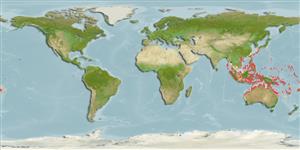>
Acanthuriformes (Surgeonfishes) >
Pomacanthidae (Angelfishes)
Etymology: Centropyge: Greek, kentron = sting + Greek, pyge = tail (Ref. 45335).
Eponymy: Willem Vrolik (1801–1863) was a Dutch anatomist and a pioneer in vertebrate teratology. [...] (Ref. 128868), visit book page.
More on author: Bleeker.
Environment: milieu / climate zone / depth range / distribution range
Ecologia
marinhas associadas(os) a recifes; não migratória; intervalo de profundidade 0 - 30 m (Ref. 128797). Tropical; 32°N - 32°S, 92°E - 173°W
Western Pacific: Christmas Island in the eastern Indian Ocean and Bali to the Marshall Islands and Vanuatu, north to southern Japan, south to Lord Howe Island. Recently recorded from Tonga (Ref. 53797).
Tamanho / Peso / Idade
Maturity: Lm ? range ? - ? cm
Max length : 12.0 cm TL macho/indeterminado; (Ref. 48636)
Espinhos dorsais (total) : 14; Raios dorsais (total) : 15 - 16; Espinhos anais: 3; Raios anais : 16 - 17; Vértebras: 24.
Inhabits lagoons and seaward reefs, mainly in coral rich areas (Ref. 1602). Feeds on algae. Oviparous (Ref. 240), monogamous (Ref. 52884). Frequently exported through the aquarium trade. Form hybrids with Centropyge eibli and C. flavissima at areas of sympatry. Mimicked by juveniles of the acanthurid Acanthurus pyroferus (Ref. 48391).
Ciclo de vida ou comportamento de acasalamento
Maturidade | Reprodução | Desova | Ovos | Fecundidade | Larvas
Distinct pairing (Ref. 205). Monogamous mating is observed as both facultative and social (Ref. 52884).
Randall, J.E., G.R. Allen and R.C. Steene, 1990. Fishes of the Great Barrier Reef and Coral Sea. University of Hawaii Press, Honolulu, Hawaii. 506 p. (Ref. 2334)
Status na Lista Vermelha da UICN (Ref. 130435: Version 2024-1)
Ameaça para os humanos
Harmless
Uso pelos humanos
Pescarias: pesca de subsistência; Aquário: Espécies comerciais
Ferramentas
Relatórios especiais
Baixar XML
Fontes da internet
Estimates based on models
Preferred temperature (Ref.
123201): 25.6 - 29.3, mean 28.6 °C (based on 1869 cells).
Índice de diversidade filogenética (Ref.
82804): PD
50 = 0.5000 [Uniqueness, from 0.5 = low to 2.0 = high].
Bayesian length-weight: a=0.03090 (0.01378 - 0.06932), b=2.88 (2.69 - 3.07), in cm total length, based on LWR estimates for this (Sub)family-body shape (Ref.
93245).
Nível Trófico (Ref.
69278): 2.8 ±0.31 se; based on food items.
Resiliência (Ref.
120179): Elevada, tempo mínimo de duplicação da população menor que 15 meses (Preliminary K or Fecundity.).
Fishing Vulnerability (Ref.
59153): Low vulnerability (10 of 100).
Nutrients (Ref.
124155): Calcium = 97.2 [49.0, 152.8] mg/100g; Iron = 0.694 [0.423, 1.136] mg/100g; Protein = 18.2 [17.0, 19.3] %; Omega3 = 0.111 [0.068, 0.180] g/100g; Selenium = 22.2 [12.5, 41.2] μg/100g; VitaminA = 98.6 [27.5, 330.1] μg/100g; Zinc = 1.68 [1.15, 2.43] mg/100g (wet weight);
